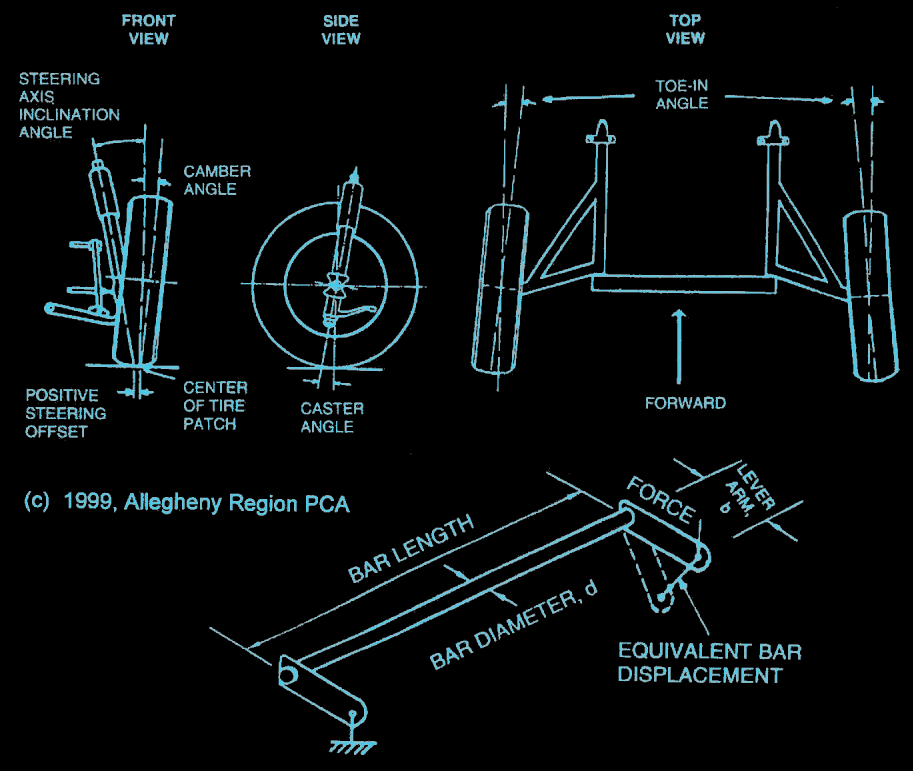
New York - Munich - Portland - San Francisco - Seattle - Stockholm - Vancouver - Zurich

New York - Munich - Portland - San Francisco - Seattle - Stockholm - Vancouver - Zurich
Q.>>>: What exactly ARE toe, camber, and caster?
A.>>>: {From the description at Tire Rack}:
Toe refers to the difference in distance between the front and the rear of the front tires. If the distance between the tires is less in the front than it is in the rear, it is referred to as toe-in. It would be what could be commonly called "pigeon toed". If the distance is greater between the front than it is in the rear, that would be toe-out.
Camber describes the amount the tire is tilted away from vertical. A tire has negative camber when the top of the tire leans inward toward the center of the vehicle. Positive camber is when the top of the tire is leaned outward from the center of the vehicle. The camber angle should be adjusted so that the tire is vertical under cornering load. Properly set camber will allow the tire to work at its best, but not have the tire putting too much of its force on the inner edge while moving in a straight line. Tire wear and handling become a compromise. Less negative camber typically will reduce the cornering ability, but give very even wear. Next time you see a photo of an Indy Car, see if you can notice how much camber there is. That is certainly an example of wear not being anywhere near as important as grip.
Caster is the most difficult of the three measurements to describe. If you think back to your bicycle and remember how the tire tilted slightly when turned, that was caster causing the tilt. If you drew an imaginary line through the upper and lower ball joints and compared the angle of difference to a line drawn perpendicular to the ground, the resulting difference is the caster angle. Caster settings allow the manufacturer to balance low speed steering effort and high speed stability. Increasing the amount of positive caster will increase low speed steering effort, but improve high speed stability. Caster also tends to cause an increase in the amount of negative camber as the steering angle is increased.
NOTE: Team3S member John T. Christian provided this diagram,
originally published by Allegheny Region Porsche Club of America:

Q.>>>: How will various camber settings affect my car's handling?
A.>>>: Camber will give you feedback on the road the more you get, and the more you add in, the larger and more defined the 'dead zone' will be at center-steering as you transition from turning one way to the other. IE: A lot of (relative) steering wheel movement will cause little actual steering movement - then, suddenly..., "ZAM!", lots of steering movement once you leave that dead-zone.
Q.>>>: I just got progressive springs installed to make my handling better. The dealer's techs are telling me that they don't think they can get the alignment back to spec. Is it unreasonable for me to ask them to get the camber to within spec setting, -0.1 to +0.1 and the toe to 0"? How much of a PITA am I being if I make those requests?
A.>>>: I'm certainly no expert, but I don't think that's unreasonable... But the acceptable range for both front and rear camber is from -.5 to +.5 , so in practical terms, anything in that range is OK. I just had my Eibachs put on and the adjustments were difficult, to say the least, but they still managed to get it to +.1... Be a PITA and insist on it. I did, and they worked at it until they got it.
For the front toe, the acceptable range is -.06" to +.06", so 0" is not unreasonable either, but in practical terms, 1/100" inch either way would not be awful. For the rear toe, the acceptable range is -.04" to +.06", so you don't want 0" as your target setting, you want +.01". Again, +/- 1/100" relative to that is not bad, IMO.
Q.>>>: Regarding the adjustment cam for rear toe adjustment (on a non-turbo FWD model): I understand that you loosen the nut on the rear, rotate the bolt head on the front to adjust the toe, and then tighten the nut back down on the rear, right? Well, the guy at Firestone (worked with him before and semi-trust him) said that the flat spot on the cam has rounded out the hole in the rear washer, and thus he can't really get my rear toe back in alignment. He says I need a new cam bolt (and washer and nut) before the toe can be adjusted. Does this sound reasonable?
A.>>>: Mine is also an NT ('94 Stealth), and the dealer's alignment guys trashed mine, and it took several days to get the eccentric head cam bolts that are required. Without them, you can't get even near spec. Since I was installing aftermarket springs, even WITH the new bolts, the best they could do without messing things up was -8/32" (-.25"), and I was happy to get that... But if you're adjusting a stock setup, they should get you close to the ideal +.1".
Q.>>>: Also regarding the rear toe adjustment: the guy at Firestone told (and showed) me the metal ring (guess it's not really a washer, but...) that's welded to the car and surrounds the big washer on the end of the adjustment cam (on the front side of it where the tick marks are for turning the bolt head). The bottom of the metal ring is still welded to the car, but the top part looks like it's "peeling off." The guy's recommendation was that I get the metal ring re-welded because that's supposed to be pretty critical to the adjustment. I got up under there last night and took a look. The service manual shows the bolt to turn to adjust toe, but it doesn't show how it actually works or if the metal ring is really crucial. Anyone care to elaborate or comment?
A.>>>: One of the other guys on the list recommended welding the washers in place (mine needed replacement), and so I asked the alignment manager to do so. They didn't argue, so I guess it's the proper method... My guy put everything on without welding first, so he could see if it should be welded off-center. Then he removed everything, did the weld, and then did the install. (I don't know if it ended up off center from the hole, but it was the right procedure).
BTW, the settings I mentioned above are for all FWD Stealth, 91 to 96. And just so you have all the info I have here on the readouts, the caster range is 3.42 to 4.42, with nominal at 3.92.
Racing Settings
Q.>>>: I intend to install the camber plates, set the car for 3-5 degrees negative camber, mark the plates, set it for 0.5 deg negative for around town, and mark the plates again. The idea is to go to the track, adjust it out to -5 deg, and then try various settings until I can get the car dialed in properly. I'll use a pyrometer to measure tire temps at left, right, and center. At the end of the track day, I'll put it back to the street settings for the drive home by going back to the street marks on the plates. Does this sound like a valid plan?
A.>>>: I'd never use more than -1 to -1.5deg on the street. -3 to -5deg camber would be required for serious competition use, and on a cheap race compound tire with lots of sidewall flex to boot. You will be losing a very great deal of road contact with that much camber dialed in. On stock suspension, I've found that -.8 to -1.2deg camber in front (depending on 245s or 275s) gives me optimal contact with the road on street tires on a course. Although technically you could benefit on paper from more camber, the fact is that street tires won't grip enough to roll the sidewall out enough to make more than -1.5 to -2deg worthwhile. And if your choice is for course use, use the course to fine-tune what you will need. Lowered, I don't see that you will need more than -2deg on the front of a VR4 (depending again on tire). I'll be interested to see what gives good temps and wear patterns. Consider toeing out the front of the car to the FAR edge of OEM spec. Now that you have lowered your center of gravity, the 'Ackerman Effect' (turn in) can really start to work in your favor.
Q.>>>: Should I have track and street settings for caster, too? If so, what do you suggest for each?
A.>>>: Some say that the more the better, but use caster for personal feel IMHO.
Q.>>>: Do you have any recommendations for changing caster/camber for various temperature profiles across the tire? Are there any rules of thumb? Is there a method of attack for working on the car trackside? (viz, do this, measure that, then do this?)
A.>>>: The hotter the outside of the tire is compared to the inside, add more negative camber. (and the other way too). But..., you will get to a point where more negative camber won't do a thing, because until you counteract ROLL in the car, you're just shoving way too much lateral momentum onto the outbound tires.
Related topic>>>: Guide to High Performance Handling from the Team3S FAQ:
Questions about your car???
Ask the other owners--
On our FREE mailing list!
Click HERE


Diagram © 2000-2004 Allegheny Region PCA, All Rights Reserved.
All Other Images © 1995-2004 Bob Forrest, All Rights Reserved.